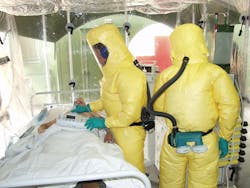In a new Cell Reports study, researchers at La Jolla Institute for Immunology demonstrate how Ebola virus has found a different way to get things done. The virus encodes only eight proteins but requires dozens of functions in its lifecycle. The new study shows how one of Ebola virus’s key proteins, VP40, uses molecular triggers in the human cell to transform itself into different tools for different jobs.
“We’re all taught that proteins have ‘a’ structure,” says study co-leader Erica Ollmann Saphire, PhD, Professor at La Jolla Institute for Immunology (LJI) and member of the LJI Center for Infectious Disease and Vaccine Research, according to a news release from the organization. “Ebola virus’s VP40 protein, however, changes itself into different structures at different times, depending on the function needed.”
VP40 is the protein that gives Ebola virus its distinctive string-like shape. Saphire’s previous studies showed that VP40 can take on a two-molecule, butterfly-shaped “dimer” or an eight-molecule, wreath-like “octamer” form.
There are dramatic rearrangements of the protein as it transforms from one to the other. The dimer is what physically constructs new viruses that emerge and release from infected cells. The octamer functions only inside the infected cell, in a controlling role, directing other steps of the viral life cycle.
The new study shows exactly what triggers these structural changes. The researchers found that VP40 senses and relies on particular human mRNA to make the transformation from the dimer to octamer.
Saphire says the study sheds light on the fundamentals of how information is encoded in the genome. There’s the genetic code, of course, but Ebola virus also controls how VP40 is deployed during different stages of its life cycle. “It has an additional layer of programming,” Saphire says.
The new study also offers further evidence that VP40 is a promising target for effective therapies. Because Ebola virus cannot spread without VP40, the virus is unlikely to acquire VP40 mutations that let it “escape” antibody therapies. This vulnerability has led the LJI team to think of VP40 as Ebola’s Achilles’ heel.

